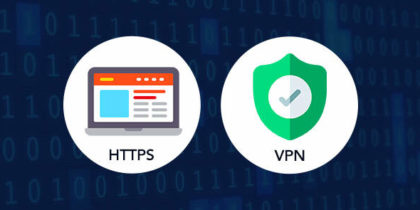More tools. More alerts. Less security.
That’s the paradox at the heart of modern cybersecurity, uncovered by our latest research.
Every digital risk brings another “must-have” security app, users are unknowingly building fragmented defenses — scattered tools that duplicate alerts, drain time, and often fail when it matters most.
This chaos isn’t rare. It’s the norm.
According to PureVPN’s research 2025, the average individual now juggles 3-5 different security apps, spending nearly 28 hours per year just managing them. Worse, 44% receive duplicate alerts, 38% admit to ignoring them entirely. The result is a hidden cost of $574–$868 per person per year – what we call the chaos tax of fragmented security.
Our findings reveal a simple truth: It’s not “more apps” that make you safer — it’s how well they work together.
The Research Findings: Fragmented Security and Alert Fatigue
Our study “The cost of fragmentation: Measuring time, spend and risk in personal cybersecurity tool stacks,” confirms what users already feel but rarely quantify: the harder we try to stay safe, the less safe we feel.
On average, most people use an average of 3.4 different security tools — such as VPNs, password managers, dark web monitors, antivirus software, browser blockers — believing each adds a new layer of safety.

But more tools often mean:
- Overlapping alerts (44%)
Our research found that nearly half of all users experience overlapping security alerts, which causes fatigue instead of awareness.
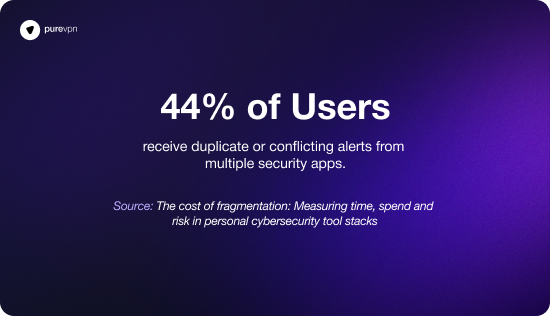
- Cognitive overload (46%)
Users are faced with constant pop-ups and noise, and nearly half of users disable key features just to get a break, a behavioral loop that undermines the very protection they paid for.
As a result:
- Ignored warnings (38%)
Our analysis of 1.5 million breaches showed that over a third of breaches target users through both stolen credentials and exposed connections.
The result is a fragmented fortress full of cracks – $400 million is lost every year to dual-vector attacks.
And when breaches strike — like the recent Google credential leak breach affecting 2.5 billion Gmail accounts or PayPal’s 16 million records exposure — this fragmentation leads to panic-switching between apps that don’t talk to each other. Instead of fast action, users scramble between dashboards, changing passwords here, scanning breaches there, and hoping one alert is the right one.
The illusion of control becomes a dangerous delay.
Read more: How PureVPN’s Password Manager Closes a Critical Security Gap.
The Hidden Cost of Fragmentation
PureVPN’s behavioral analysis shows that fragmentation creates a measurable “chaos tax,” which on average leads to:
- 27.6 hours a year – that’s how long the user spends managing their personal security tools
- 38% of users ignore alerts or miss threats due to alert fatigue.
- Annual direct spend is $92 per user, but 34–40% of it is wasted on redundant or unused features.
- Alert review adds another 9 hours/year, worth $180–270, with rework from ignored alerts adding $180–300 more.
Together, that’s $574–$868 per person, per year — a user pays on overlapping cybersecurity apps.
The Three Verticals of Fragmentation
When breaches strike, every second matters. But fragmentation slows users down. Our analysis found that user struggles fall into three verticals:
- Fragmented Access = Inertia: Switching between apps, re-authenticating, and juggling multiple consoles creates a “time tax” that makes people delay critical updates.
- Fragmented Alerts = Inaction: Duplicate and noisy alerts drive alert fatigue, leading to skipped notifications and delayed responses.
- Fragmented Functionality = Gaps: Misconfigured or disabled tools — plus underused paid features — create security blind spots, leaving users exposed while thinking they’re safe.
This trio of issues forms a self-reinforcing vicious loop where fatigue leads to inertia, and inertia creates more exposure, and exposure fuels more panic.
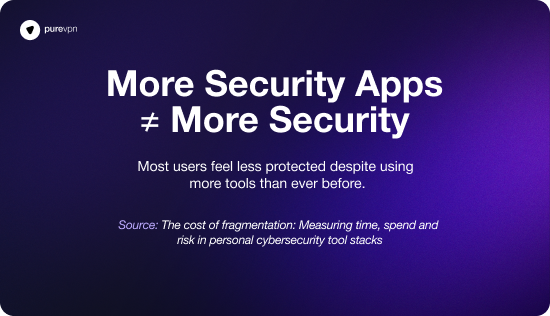
Think about it: what’s the point of paying for four apps if you’re too overwhelmed to use them when you need them most?
For individual users, alert noise fuels inertia and creates functionality gaps. Duplicated or conflicting alerts reduce trust, causing users to delay updates or leave tools disabled, which increases exposure. Unlike enterprises with IT support, individuals rely on guesswork, leading to risky inaction or overreliance on a single familiar tool — even if it’s ineffective.
Behavioral Impacts: The False Sense of Security
Fragmentation isn’t just financial — it reshapes behavior.
Many users assume that “more tools = more safety.” In reality:
- Many users assume they’re protected simply because they have multiple tools installed.
- 29-34% admit to postponing critical updates when overwhelmed by alerts.
- Cognitive overload from juggling alerts leads to missed warnings.
- Inconsistent alerts create false confidence — people believe they’re protected when they’re not.
This is the classic alert fatigue trap: the more tools you add, the less you act on them.
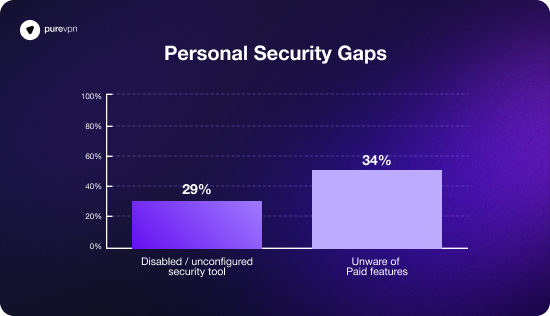
Enterprise Parallels: When More Tools Mean Less Security
This pattern isn’t just personal. At the enterprise level, organizations deploy dozens of tools but face the same gaps.
- A quarter of enterprises use 76+ security tools, yet only 36% of leaders feel confident they’re fully effective.
- Verizon DBIR 2025 reports a 34% increase in attacks exploiting configuration gaps year-over-year.
Whether individual or enterprise, the outcome is the same: More tools haven’t created stronger protection — just more complexity to manage.
PureVPN: One App. Complete Protection.
To address this gap, PureVPN offers unified security within a single ecosystem, where each feature reinforces the others. The app replaces fragmentation with clarity and emphasizes personal security with one guiding principle: integration over addition.
The app unifies VPN, Password Manager, Dark Web Monitoring, Tracker & Ad Blocker, and Data Removal into a single coordinated platform. No more hopping between tools, no more alert fatigue, no more security blind spots. Just one app, one workflow, and complete protection.
You get:
- One alert stream with prioritized guidance.
- One workflow to act fast during incidents.
- One subscription that covers your entire protection stack.
Our unified app brings together:
- Full-Featured VPN – Encrypts your entire connection, masks IPs, blocks DNS leaks, and so much more.
- Password Manager – Secures, generates, and auto-fills logins with Zero Knowledge Architecture.
- Dark Web Monitoring – Continuously scans for leaked critical identifiers and sends timely alerts in case your data appears on the dark web.
- Tracker & Ad Blocker – Stops intrusive ads and third-party trackers in real-time.
- Data Removal Tool – Helps you reclaim your personal information from broker databases.
Together, they form a coordinated security pipeline: VPN protects traffic, Password Manager secures credentials, Tracker & Ad Blocker reduces exposure, and Dark Web Monitoring alerts you if your personal information appears on the hidden parts of the internet — all from one place.
Read more: Stop websites from spying on you with the Tracker Blocker feature.
Bottom Navigation: Security Where Your Thumb Expects It
This isn’t just about unification — it’s about accessibility in moments of crisis.
The new bottom navigation on Android and iOS makes breach-response tools instantly reachable, making sure all your security tools are exactly where your thumb expects them to be — accessible in seconds, even during a crisis. Because when every second counts, simplicity isn’t just convenience — it’s security:
- Crisis-Optimized Access: All security tools are easily accessible.
- Alert Consolidation: One notification stream, prioritized so you know what to do first.
- Seamless Workflow: No more hopping between apps; act in one tap.
When panic hits, clarity matters more than features.
Why It Matters: Less Chaos, More Security
Our research proves fragmentation doesn’t just waste money — it leaves users vulnerable.
- Time tax: 27.6 hours/year lost.
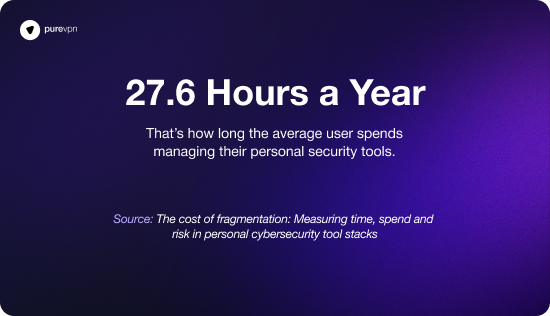
- Redundant spend: 24% of subscriptions overlap.
- Ignored alerts: 38% skipped due to overload. The study indicates that roughly two-thirds of alerts are ignored or not investigated due to high volumes and noise. Only about one-third of alerts receive attention (“Alerts Addressed”). This highlights the extent of alert fatigue and inaction.
PureVPN solves all three with one app, one workflow, one subscription.
“Security isn’t about how many tools you have — it’s about how well they work together when it matters most.”
— Ali Khan, Head of Product, PureVPN
Case Study:
I. The Content Creator Under Pressure
Profile: Age 25, Influencer with multiple social accounts, intermediate technical skills.
This user installed five different tools to guard against account hijacking: a VPN, a browser extension blocker, two separate password managers (one free, one premium), and a dark web checker. Despite the investment, they fell victim to an Instagram account takeover in 2024.
Why? One password manager flagged a weak credential, but the alert was lost among redundant notifications. Believing “the other app would cover it,” they ignored the warning. The breach cost them brand sponsorships and weeks of recovery.
Monetary Snapshot
- Time tax (app juggling): 4 h/month → 48 h/year → $960–1,440/year.
- Alert review fatigue: 12 h/year → $240–360/year.
- Direct spend waste: ≥ $50–70/year (multiple premium tools).
Cost tag (annual, indicative): $1,250–1,870/year in upkeep, redundant spend, and ignored alerts — not counting the financial loss of account hijacking.
II. The Always-On Mobile Professional
Profile: Age 34, Frequent traveler, heavy use of public Wi-Fi.
This user depends on connectivity in airports, cafés, and hotels — places where unsecured networks are the norm. To stay safe, they installed a VPN, a mobile password manager, and a standalone dark web monitoring app. But switching between tools while rushing through boarding gates or meetings led to missed updates and delayed responses.
When the August 2025 PayPal breach hit, they received multiple conflicting alerts — one to reset a password, another warning of dark web exposure. Uncertain which to prioritize, they postponed action until hours later, increasing their risk window.
Monetary Snapshot
- Time tax (multi-app management): ~3 h/month → 36 h/year → $720–1,080/year.
- Alert review & confusion: ~10 h/year → $200–300/year.
- Direct spend waste: ~$31–40/year on overlaps.
Cost tag (annual, indicative): $951–1,420/year in time, wasted spend, and delayed action, with added exposure risk due to mobile breach scenarios.
Why These Stories Matter
These case studies make one thing clear: fragmentation doesn’t just waste money — it creates blind spots that attackers exploit.
Whether you’re a cautious parent, a tech enthusiast, a traveler, or a creator, the pattern is the same:
- More tools = more overlap.
- More alerts = more ignored warnings.
- More friction = slower breach response.
PureVPN’s Max Plan with Bottom Navigation solves this by unifying protections into one app, one workflow, and one set of prioritized alerts. No juggling. No chaos tax.
Recommendations That Work
The good news is that fragmentation can be fixed. Based on survey data and user interviews, here are research-backed best practices:
- Inventory & Simplify: List all your tools and cut out overlapping ones. Focus on essentials: VPN, password manager, dark web monitoring, backups.
- Configure & Activate: Don’t leave protections disabled or unconfigured. Make sure every core feature is actually running across your devices.
- Tune Your Alerts: Keep only high-severity alerts. Silence repetitive, low-value notifications to avoid alert fatigue.
- Cut Redundant Spend: Cancel overlapping subscriptions. Consolidation saves money without reducing security.
- Time-Box Maintenance: Instead of constant interruptions, schedule 30–45 minutes a month to check updates and verify protections.
- Measure What Matters: Track your “time tax,” duplicate alerts, ignored alerts, and wasted spend. Aim to cut duplicate alerts by half and reduce maintenance time to under one hour per month.
Final Word: Stop Paying the Chaos Tax
More tools don’t mean more protection — they mean more chaos, fatigue and blind security spots.
PureVPN brings clarity, speed, and complete protection in one app built for real-world crises.
Because when breaches strike, your security should be fast, unified, and exactly where you need it.
Get started with PureVPN’s Max Plan today.
For details on pricing and offers, click here. And don’t forget to follow PureVPN Blog for more insights, research updates, and exclusive deals.

![How to Fix YouTube TV VPN Proxy Detected Error [Updated 2025]](https://www.purevpn.com/wp-content/uploads/2021/09/youtube-tv-vpn-proxy-detected-420x210.jpg)
